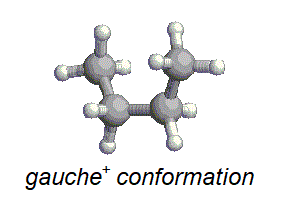Introduction to Structural Chemistry
Introduction to Structural Chemistry
Structural Chemistry is a branch of chemistry that focuses on the qualitative and quantitative description of the structure of individual molecules and crystals.
But what does it mean to understand the structure?
Structure, in general terms, refers to the composition and arrangement of elements that, through relationships of correlation and functional interdependence, form an organic complex or one of its parts.
In chemistry, the term "structure" is utilized in different situations.
It is used to describe the arrangement of electrons in atoms and molecules:
Electronic structure
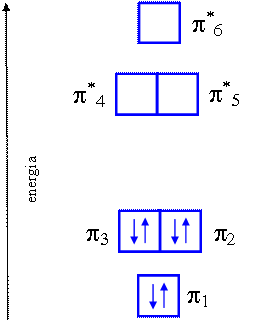
Electronic structure of benzene
Knowing the electronic structure of an atom or molecule means understanding the arrangement of electrons in their respective atomic or molecular orbitals.
it is used for the spatial arrangement of atoms within molecules:
Molecular structure
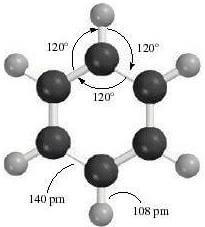
Molecular structure of benzene
Knowing the molecular structure means knowing the number and kinds of atoms and their 3-D arrangement.
and it is used for crystals:
Crystal structure
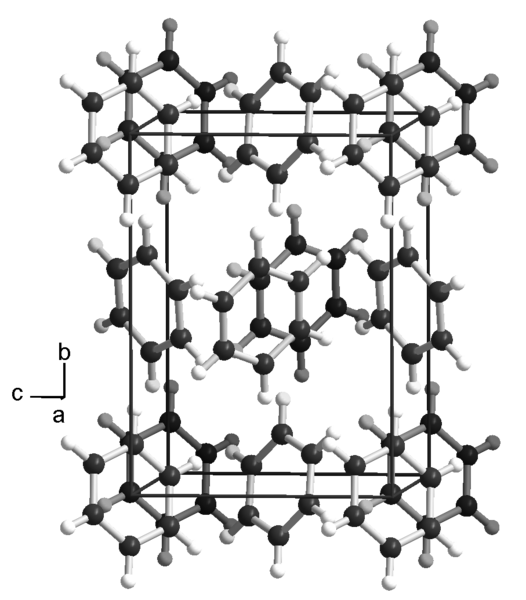
Crystal structure of benzene
Knowing the crystal structure means knowing the unit cell, the crystal symmetry, and the asymmetric unit regarding the number and kinds of atoms and their positions in the unit cell.
The Importance of Molecular and Crystalline Structure
The physical-chemistry properties of the allotropic forms of carbon, closely related to their crystalline structure (structure-property relationship), highlight the importance of structural studies and chemical structure analysis.
Allotropic forms of carbon
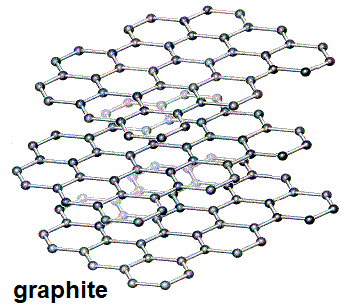
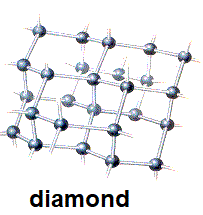
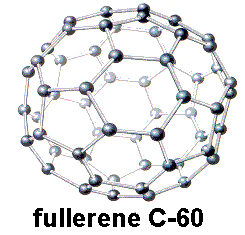
Properties such as hardness, electrical conductivity, and color vary significantly among these three allotropic forms of carbon, depending on how the carbon atoms are bonded to each other.
Morphology and cutting, for example, are two properties that depend specifically on the crystalline structure and the type and orientation of chemical bonds. Crystals fracture along crystallographic planes that develop along weak bonds or with a low density of bonds per surface area.
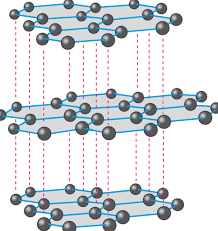
For example, in graphite, the (001) crystallographic planes between graphene layers can be easily separated because they are held together only by van der Waals forces. Thus, graphite crystals have a very developed and almost perfect {001} face. The easy sliding of the (001) planes and the easy exfoliation of graphite are used in many applications, including the use of graphite as a dry lubricant.
In diamond, the (111) crystallographic planes intersect a minimum number of C-C covalent bonds per unit area. Although these bonds are difficult to break, these are the planes that are used to cut diamonds, which will then show the {111} faces and equivalents by symmetry.
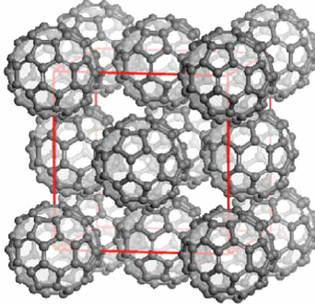
The molecular crystal of fullerene has a melting temperature of around 220 °C, which is significantly lower than the sublimation temperature of graphene (3600–3700 °C).
Allotropic Forms of Tin
The importance of structure is also very evident in the phenomenon of tin pest.
The element Sn has two allotropic forms:
Alpha tin (gray tin): density 5.769 g/cm-3; coordination number 4
Beta tin (white tin): density 7.265 g/cm-3; coordination number 6
Solid/solid transition: Alpha tin (gray tin) < 13.2 °C > Beta tin (white tin)
White beta tin with metallic characteristics, slowly reconverts to the gray alpha allotropic form when cooled, giving rise to the phenomenon of tin pest.

The Structure of Molecules, Covalent Bonding, and Geometric Parameters
By definition, in molecules, atoms are bound by covalent bonds. Bond length is the most important geometric parameter characterizing a chemical bond, representing the distance between the nuclei of two covalently bonded atoms.
In an orthonormal system, the bond length (dAB) between A with coordinates XA, YA, ZA and B with coordinates XB, YB, ZB is equal to:
dAB = √[(XA-XB)2+(YA-YB)2+(ZA-ZB)2]
It is an average value, as each atom vibrates around its central equilibrium position. It can be measured experimentally, such as by determining the crystal structure through X-ray diffraction, or calculated theoretically using quantum mechanical methods.
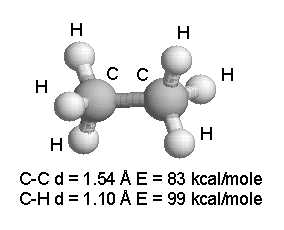
1 Å = 10-10 m = 0.1 nm
The bond length depends on the chemical species involved in the bond (covalent radius of the element) and the nature of the bond.
The bond length for a given pair of atomic species depends on the bond order.
Relationship between: Bond order - Bond energy - Bond length
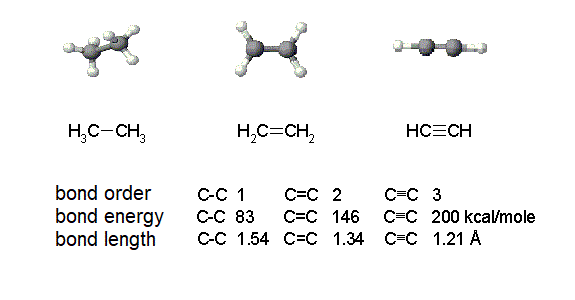
In covalent bonds where electrons are delocalized over multiple centers, as described by resonance formulas, the bond length is intermediate between the values expected from the individual limit structures.
C-C bond length in benzene is 1.40 Å, an intermediate distance between 1.54 Å of ethane and 1.34 Å of ethylene.
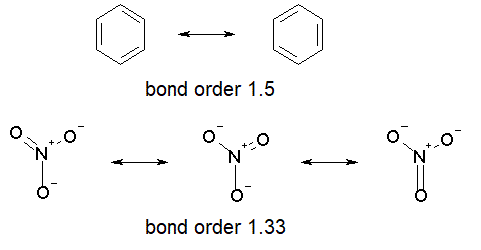
In the presence of resonance structures with charge separation, as in the nitrate ion, the bond length is shorter than expected based on the bond order.
dN-O single bond 1.43 Å
dN=O double bond 1.20 Å.
In the nitrate ion, given the bond order of 1.33, a bond length closer to that of a single bond is expected, compared to a double bond. However, the ionic character of the bonds tends to shorten the bond length, making it closer to that of a double bond.
dNO in the nitrate ion 1.22 Å
For the same chemical elements and bond order, the bond length depends on the shape of the bonding molecular orbitals, which, according to valence bond theory, reflect the hybridization of the atomic orbitals involved in the bond. For the C-C single-bond:
dCsp3–Csp3 1.54 > dCsp3–Csp2 1.50 > dCsp2–Csp2 1.47 > dCsp3–Csp 1.46 > dCsp2–Csp 1.43 > dCsp–Csp 1.37 Å
Hybridization particularly determines the geometric structural parameter: bond angle.
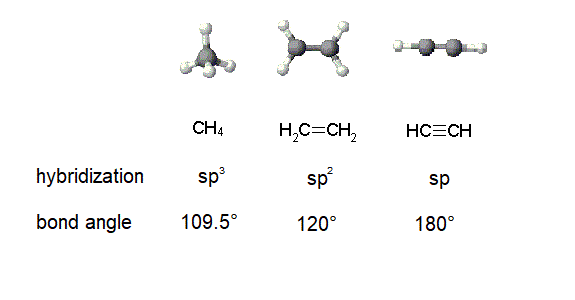
The bond angle is the angle between the two lines passing through the nuclei of the bonded atoms.
The bond angle (θABC) can be calculated from the interatomic distances dAB, dAC, and dBC:
θABC = arcos[(dAB2+dBC2-dAC2)/(2dABdBC)]
It depends on the distribution of valence electron pairs around the central atom (see VSEPR theory), and its deformation from the ideal geometry is influenced by electrostatic repulsions, such as those exerted by non-bonding electron pairs.
- Non-bonding pairs occupy more space than bonding pairs;
- Triple bond pairs occupy more space than double bonds, which occupy more space than single bonds;
- Bonding pairs occupy less space as the electronegativity of the bonded atom increases.
The deformation of bond angles from ideal geometry explains the reactivity of certain molecules, such as cyclopropane and cyclobutane (due to ring strain), as well as molecules like the allotropic form of white phosphorus, which adopts a tetrahedral shape with very narrow bond angles.
Three consecutive covalent bonds linking 4 atoms (ABCD) determine an important structural parameter widely used to describe the conformation of molecules: The torsional angle, ωABCD.
The torsional angle, ωABCD, is defined as the dihedral angle between the two planes that contain the three non-collinear atoms ABC and the three non-collinear atoms BCD, respectively, which share the line passing through the central bond BC. By convention, the angle ωABCD assumes values from -180 to +180° and is positive if the rotation from BA to CD, viewed along the BC bond, is clockwise; it is negative if counterclockwise. Note that the sign of the angle does not depend on the direction in which the atoms ABCD are labeled, in other words, ωABCD = ωDCBA. Torsion angles change sign in the mirror image or inverted molecule.
The torsion angle can be calculated as:
ωABCD=arccos[(nABC·nBCD)/(|nABC||nBCD|)]
where nABC and nBCD represent the normal vectors to the planes ABC and BCD, respectively, and are obtained by the cross product of the vectors AB and BC and the cross product of the vectors BC and CD.
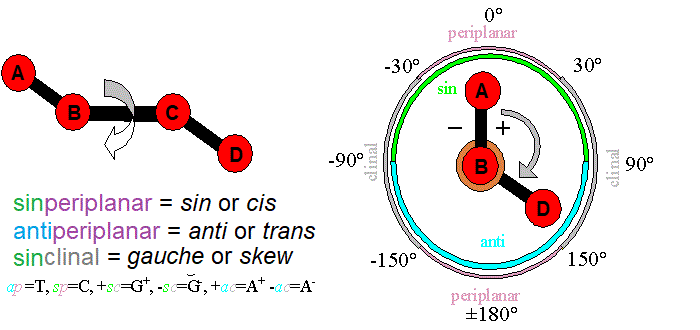
Stereoisomerism and Conformation
The chemical structure and spatial arrangement of atoms form the basis of stereochemical studies.
Stereoisomers have the same atom-to-atom connectivity but differ in their non-superimposable three-dimensional structure. If the difference in geometric structure arises from torsion angles that involve single bonds, they are called conformational stereoisomers or conformers. Non-conformational stereoisomers are known as configurational isomers.
Dimensions of Atoms
Heisenberg's uncertainty principle has led to the modern quantum mechanical description of the atom. The state of electrons is represented by wave functions. The probabilistic interpretation of electron localization around the nucleus suggests that, theoretically, the volume of a single atom is infinite. In reality, the radial probability of finding an electron decreases asymptotically as the distance from the nucleus increases. However, in the condensed state of matter, the nuclei of atoms, shielded by the electron density, are arranged in close proximity (on the order of angstroms), making it useful to describe atoms as having finite dimensions.
Considering a spherical symmetry for the atom, the sphere radius describes the size of the single atom.
Each chemical element has an atomic radius that depends on the context in which the atom is found.
The atomic radius is theoretically calculated using quantum methods and is defined as the radius of a sphere that encloses a certain probability (typically 95%) of finding the electron.
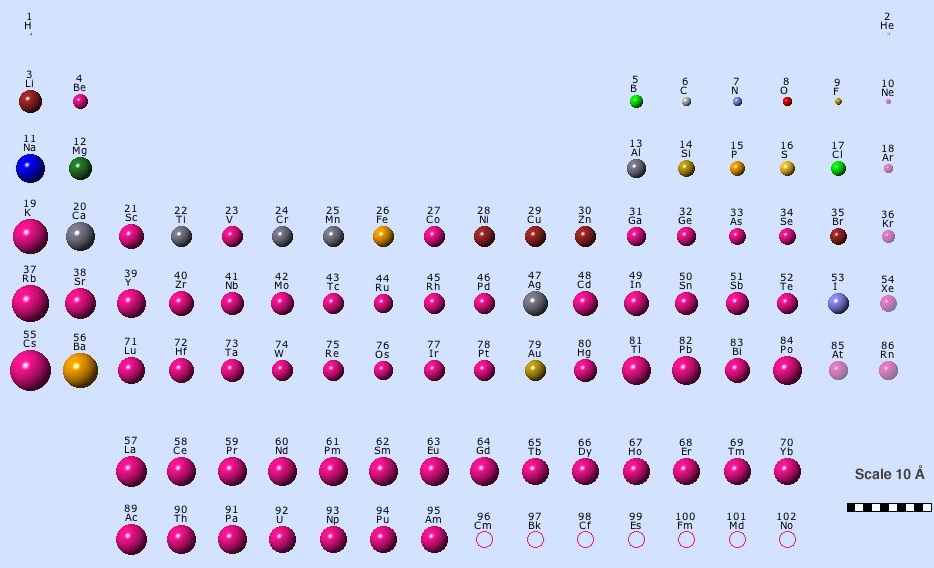
The covalent radius is derived from experimental bond distance values obtained through X-ray diffraction.
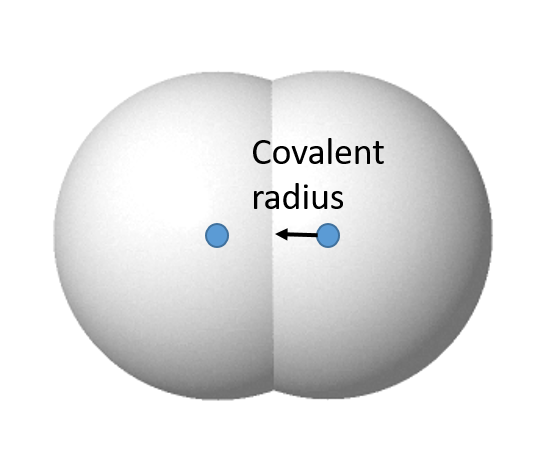
It is generally assumed that the bond distance is equal to the sum of the covalent radii of the two bonded atoms. However, this assumption is not strictly valid, as bond distances are influenced by several factors. Despite this limitation, covalent radii for various elements have been determined and tabulated according to bond order: Single-bond, double-bond, and triple-bond covalent radii. These values are useful for predicting bond distances and understanding the relationship between bond distances and bond order.

Similarly, for ionic compounds, ionic radii, representing the radii of cations and anions, have been determined. For each element, the ionic radius varies depending on the charge of the ion. Additionally, different scales exist for ionic radii, depending on the criteria used to distribute electrons between atoms (Shannon's revisited ionic radii).
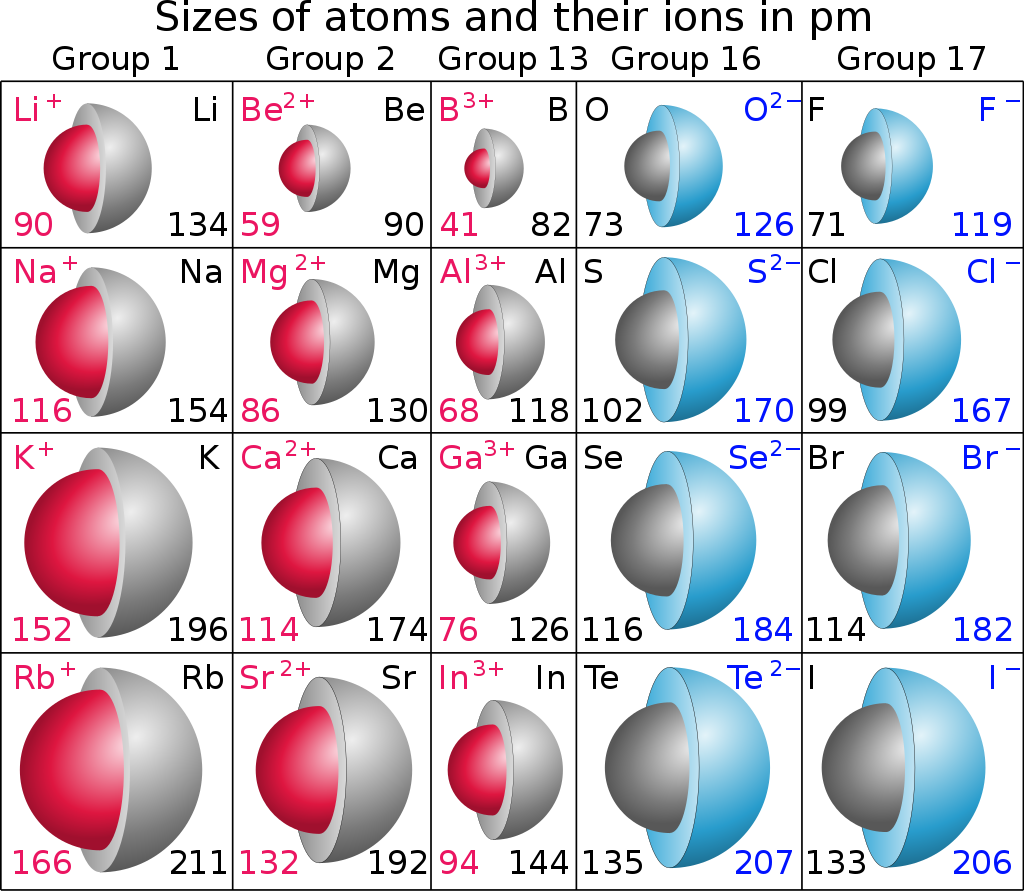
The metallic radius, which is determined experimentally using diffraction data, depends on the coordination number of the element in the metal. Metallic radii for a coordination number of 12, corresponding to a close-packed metal arrangement, have been tabulated by Pauling.
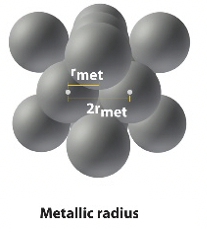
The van der Waals radius, historically derived from the covolume of gases, is used to describe atoms that are not covalently bonded but interact in the condensed phase through van der Waals forces. The recommended van der Waals radii for various chemical elements were calculated by Bondi.
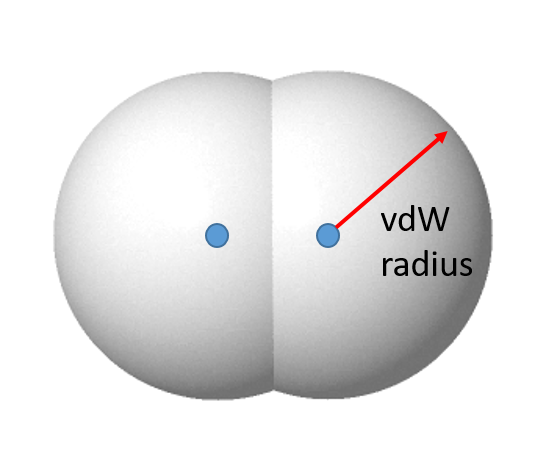
The Bond Valence Sum Method
The bond valence sum method is used in chemical structure analysis and coordination chemistry to estimate the valence and oxidation states of atoms. It is based on the concept of valence, the number of electrons an atom uses in bonds, developed by Linus Pauling, a two-time Nobel Prize winner (in Chemistry and Peace) and author of the renowned book "The Nature of the Chemical Bond".
Valence is defined by IUPAC as the maximum number of univalent atoms (originally hydrogen or chlorine atoms) that may combine with an atom of the element under consideration, or with a fragment, or for which an atom of this element can be substituted
The valence of an atom has also been defined as the number of valence electrons of the atom minus the non-bonding electrons of the atom (J. Chem. Educ. 2006, 83, 5, 791).
Despite efforts to define valence rigorously, the term remains ambiguous, though it is still widely used in various contexts. In contrast, oxidation number, formal charge, and coordination number are more precisely defined
Nevertheless, despite these limitations, the empirical bond valence sum method remains a simple and useful model for validating chemical structures and predicting certain properties.
The method is based on the principle that the valence V of an atom is equal to the sum of the individual bond valences vi surrounding it.
Where the individual bond valences vi are calculated from the experimentally observed bond lengths Ri using the formula:
Where b is an empirical constant, generally equal to 0.37, and Ro is a tabulated value for each single-bond pair, corresponding to a valence of 1.
Updated parameters are available from the International Union of Crystallography (IUCr) Bond valence parameters.
Example of the use of the Bond Valence Sum for determining the oxidation state of metal and the protonation level of oxygens.
E.g., Polyoxometalate Embedding of a Tetraruthenium(IV)-oxo-core from J. Am. Chem. Soc. 2008, 130, 15, 5006–5007.
Tutorial for BVS Exercise
Starting point: Crystals were obtained in water containing excess CsCl and
K8SiW10O36·12H2O: potassium salt of polyoxometalate (POM) [γ-SiW10O36]8-
K4Ru2OCl10: potassium salt of μ-oxo-bis-pentachlororuthenate(IV) [Ru2OCl10]4-, which polymerizes in water to form the tetranuclear ruthenium(IV) aqua-complex: [Ru4O6(H2O)12]4+
Modeling Steps in Jmol
1. Visualization Setup
• Show 3x3 unit cell (crystal packing)
• Show molecule (asymmetric unit)
• Count independent Cs+ ions
• Determine POM molecule charge
2. Selection and Display
• Show 1x1 unit cell:
• Select and display only the selection
• open console
• Select a specific atom of the POM (e.g. @149) and its connected atoms
• write in console: select @149
• write in console: select selected or connected(selected)
• repeat: select selected or connected(selected), until all POM is displayed
• Remove display cell and show various representations of POM:
• show spacefill
• show surface
• show dots
3. Bond Valence Sum (BVS) Calculations
For Silicon (Si):
• Selection and coordination measurement:
• select @149
• select selected or connected(selected)
• measure coordination bond lengths by double clicks on atoms
BVS Calculation:
• calculate BVS using RoSi4O-2 = 1.624 Å and confirm the Si oxidation state
For Tungsten (W):
• Selection and coordination measurement:
• select @207
• select selected or connected(selected) and measure coordination bond lengths
• BVS Calculation:
• calculate BVS using RoW4O-2 = 1.851 Å and RoW6O-2 = 1.917 Å and confirm the oxidation state
For Ruthenium (Ru):
• Selection and coordination measurement:
• select @216
• select selected or connected(selected) and measure coordination bond lengths
• BVS Calculation:
• calculate BVS using RoRu3O-2 = 1.770 Å and RoRu4O-2 = 1.834 Å and confirm the oxidation state
4. Charge Balance Calculation
• calculate the total positive charge.
• calculate the potential negative charges.
• considering protonation: some O-atoms are protonated to form coordinated OH- ions or H2O molecules.
• found the protonated O-atoms using BVS analysis.
5. Measuring Bond Lengths for Oxygen Species
• measure coordinations bond lengths of bridging μ4-O and calculate BVS
• measure coordinations bond lengths of bridging μ3-O and calculate BVS
• measure coordinations bond lengths of bridging μ-O and calculate BVS
• measure coordinations bond length of terminal O and calculate BVS
Final Formula Determination
• Show molecule (asymmetric unit)
• Count independent co-crystallized water molecules
Proposed Formula:
Cs10[Ru4(μ-O)4(μ-OH)2(H2O)4(γ-SiW10O36)2]·16H2O

